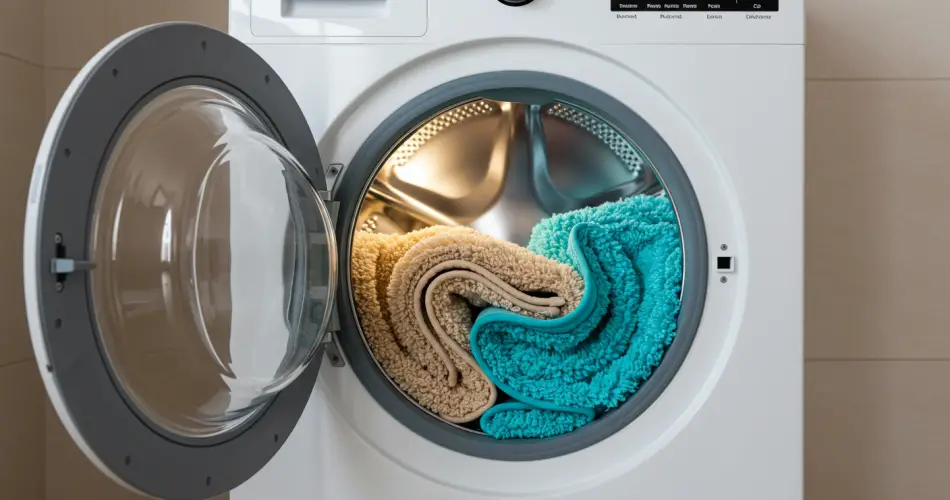The washing machine has been a household staple for decades, allowing people to clean their clothes quickly, efficiently, and with little effort. With just the push of a button, garments come out fresh, disinfected, and ready to wear again. It’s no wonder that surveys show around 60% of people consider the washing machine one of the most indispensable appliances in the home.
However, while it is designed to handle most laundry tasks, not everything should go into the machine. One item in particular that raises concern is the bathroom rug or bath mat. Many people casually toss their bath mats in with towels and other laundry, not realizing that this practice can damage both the rug and the washing machine.
So why is it discouraged? Let’s take a closer look at the reasons behind this advice and explore the proper way to keep your bathroom rugs clean and fresh.
Why Bath Mats Are Problematic in the Washing Machine
At first glance, a bathroom rug seems like an item that belongs in the laundry. After all, it collects dust, moisture, and bacteria daily. However, bath mats present unique challenges that can make machine washing risky.
-
Material Wear and Tear
Most bath mats are made of fabrics like cotton, microfiber, or blends that are backed with non-slip rubber or latex. While the soft fabric may survive a cycle or two, the rubber backing is highly vulnerable to heat, detergent, and spinning. Over time, the rubber cracks, peels, or disintegrates, leaving bits of debris inside the washer drum. -
Risk of Machine Damage
When the rubber or latex backing breaks down, the debris can clog the washing machine’s filter or pump, leading to drainage issues and costly repairs. In some cases, heavy mats may also strain the motor, especially if they absorb too much water and become excessively heavy during the cycle. -
Hygiene Concerns
Bath mats are constantly exposed to moisture and warmth, creating the perfect environment for bacteria and mold. While a washing machine can certainly sanitize them under the right conditions, many people wash them at lower temperatures to avoid damage. Unfortunately, this means that harmful microbes may not be fully eliminated. -
Shape Distortion
The spinning and agitation inside the washer can cause bathroom rugs to lose their shape. You might notice curling edges, stretched fabric, or a mat that no longer lies flat on the floor, reducing both comfort and safety.
Safer Alternatives for Cleaning Bathroom Rugs
If machine washing is risky, how should you clean bathroom rugs? Fortunately, there are several effective methods that don’t put your appliance—or your rugs—at risk.
1. Hand Washing with Mild Soap
The safest method is to wash bathroom rugs by hand. Fill a basin or bathtub with warm water and add a mild detergent or neutral soap. Soak the rug for 15–20 minutes, then gently scrub it with a soft brush. Rinse thoroughly with clean water to remove any soap residue. This method is gentle and prolongs the life of the rug.
2. Natural Cleaning Solutions
If you want to disinfect without harsh chemicals, natural ingredients like white vinegar and baking soda work wonders. Add half a cup of vinegar to a bucket of warm water and soak the rug. Baking soda can be sprinkled directly onto stubborn stains before scrubbing. Both ingredients have antibacterial properties and help neutralize odors.
3. Spot Cleaning
For small stains or areas with dirt buildup, spot cleaning is often enough. Use a damp cloth, mild soap, or a natural cleaner to treat the area without soaking the entire rug. This method works well for rugs that only need a quick refresh.
Can You Ever Use the Washing Machine?
Despite the risks, many people still prefer the convenience of machine washing. The good news is that it can be done—if you take certain precautions.
-
Check the Care Label: Always read the manufacturer’s instructions. Some rugs are specifically labeled as machine-washable, while others are not.
-
Choose the Right Cycle: Use a gentle or delicate cycle with cold or lukewarm water. High temperatures damage the rubber backing more quickly.
-
Low Spin Speed: Keep the spin speed low to reduce strain on both the mat and the machine.
-
Avoid Harsh Detergents: Opt for mild detergents instead of strong chemicals or bleach, which can degrade fabric and rubber.
-
Dry Immediately: Never leave a damp rug sitting after washing. Lay it flat or hang it outside to dry as quickly as possible. This prevents odors, mold, and deformation. Avoid tumble dryers, as heat can melt or crack the backing.
If followed carefully, these precautions can allow you to wash your rugs in the machine occasionally without causing major damage.
How Often Should You Wash Bathroom Rugs?
Bathroom rugs should ideally be cleaned every one to two weeks, depending on household traffic and usage. In high-humidity environments or large families, more frequent cleaning may be necessary. A good rule of thumb is to wash or disinfect the mat as soon as it begins to feel damp, smell musty, or show visible dirt.
Final Thoughts
The washing machine is one of the greatest time-saving inventions of the modern household, but it is not suited for every fabric or household item. Bathroom rugs, while seemingly harmless, can pose risks to both the appliance and the rug itself when washed improperly.
The safest way to care for them is through hand washing or natural cleaning methods, which keep the rugs fresh, hygienic, and long-lasting. If you do choose to machine wash them, take precautions: use delicate cycles, avoid high heat, and dry them immediately.
By understanding the risks and alternatives, you can keep your bathroom clean and comfortable without damaging your essential household appliances.



